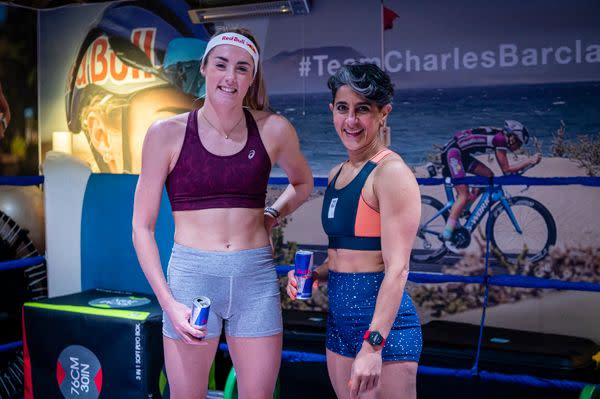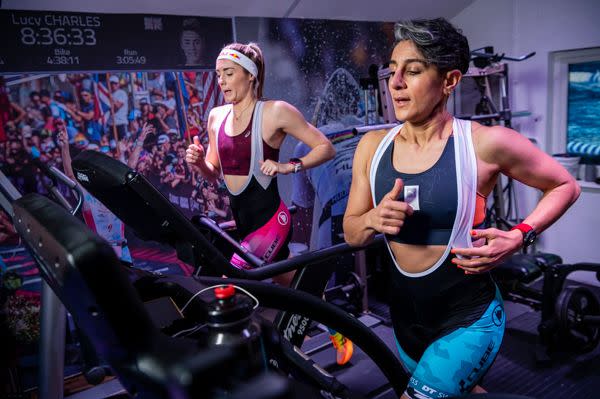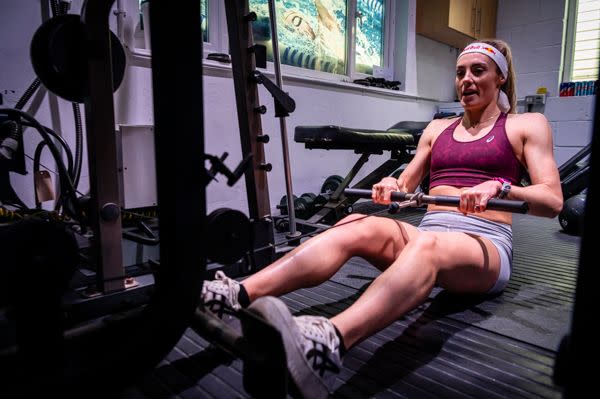'I trained with a World Champion Ironman athlete, here's everything I learned'

Doing a 2.4-mile (3.9K) swim, 112-mile (180K) bike, and a 26.2-mile (42.2K) run, in one trot, is what you're working towards with an Ironman training plan. It's what makes up an Ironman triathlon, one of the hardest multisport endurance events around.
I’ve always known Ironman triathletes are hardcore and I love a challenge, so when an invite to train with world champion Lucy Charles-Barclay came in I was first to put my hand up. There was just one problem: I don’t swim. ‘No problem,’ Lucy’s team at Redbull (her sponsors) said. ‘Come down to ‘The Pain Cave’ where Lucy trains, and have a go at her bike, run and strength training sessions.’ Next thing I know, I’m on a train to Essex to meet #TeamCharlesBarclay to see what training like an Ironman pro really looks like.

A bit of context for you: coming from a semi-pro background in swimming (just narrowly missing the Team GB Olympics team in 2012), Lucy turned to triathlon events ‘for fun’ and won the Ironman World Champion amateur group in 2015. That’s when going pro suddenly came into sight.
‘It quite quickly became my career, when it was only really meant to be something for fun. Even though I'm competing at the highest level, I want to keep it fun. I think you perform better if you're enjoying what you're doing. So that's what we always try to focus on,’ she tells me. Sure enough, in 2021, she won the Ironman 70.3 World Championships as an elite.
Lucy’s Ironman training plan
Monday morning: swim (around 4500-5000m). ‘Most sessions are at least 5000m.’
Monday afternoon: strength training. ‘It’s a slightly easier day, after generally a large volume of training at the weekend.’
Tuesday morning: high-intensity run; usually 4-5 km intervals on the treadmill or track, maybe continuously up to half marathon distance. Followed by an ‘easy cycle’ for around 60-90 minutes ‘to build up base and endurance’.
Tuesday evening: key swimming session, normally around two hours with the club. ‘Tuesdays are quite a hard day because there's a hard run and a hard swim so fueling is really important.’
Wednesday morning: ‘Hard, chunky bike workout’, normally a minimum of two hours and up to four, including intervals.
Wednesday evening: easy run, from 40 minutes to an hour.
Thursday morning: swim followed by a short, high-intensity cycle or run in the afternoon.
Thursday evening: swim. ‘The morning swim will be quite easy, but the evening swim is harder. I tend to find when you go again in the evening, you just feel more powerful in the water.’
Friday morning: swim and strength work.
Friday afternoon: cycle or run, around 2-3 hours with ‘a small block of work, say 20 minutes of intervals’.
Saturday morning: ParkRun (5km run). ‘As the season progresses I might turn that into a long run if we run there and run back.’
Saturday afternoon: easier cycle.
Sunday: long bike ride – ‘a minimum of four hours and it can go up to five or six hours’.
Lucy gave me just a taster of this gruelling programme in our morning together. While I tried to keep up, she shared some golden insider tips. Here’s what I learned about bossing an Ironman triathlon while I trained like one. See you at the start line?

1. The bike is more technical than it seems
Most of Lucy’s cycling training is done indoors on her Wahoo – an indoor cycling training app. This means she can avoid traffic and stop-starts, and train at specific speeds, power and cadence (the number of revolutions your pedals make per minute as you ride) that will help push her gains on the bike. In her training space, aptly named The Pain Cave, there are two screens and two bikes set up so her husband Reece Barclay (also a pro Ironman triathlete and one of her coaches) joins her on most training sessions. Coming from elite swimming, she says the bike is her weakest discipline so there’s always work to do.
‘When I first came into triathlon, I couldn't get my heart rate up on the bike. I just didn't have the strength to push enough power. It’s been years of hours spent on the bike and in the gym to develop the strength and technique to push more power,’ she tells me.
What’s the trick? ‘You want to focus on not only pushing down the pedals but pulling up too. So you’re using your quads as you push and hamstrings as you pull. That way you're getting more efficiency out of each pedal stroke.’ Noted.
What about the gym – what strength work is good for cycling? ‘Single-leg unilateral exercises like lunges, single-leg leg press and hamstring curl leg extensions work better for cycling.’
We did a sequence of weighted lunges (light weight) with a press overhead, goblet squats and kettlebell swings, which served as a warm-up to strength work, as well as a mobility piece. The lunges (with the same foot going forwards and back) seemed easy enough, until Lucy told me not to put my foot down in the middle. ‘That way it works your balance and core stability by having to keep your hips straight and balanced.’
2. Brick runs are an essential part of Ironman training

For the non-triathletes, a brick workout (which unfortunately, is as hard as it sounds) is training two disciplines back-to-back; in this case, a bike workout followed immediately by a run.
It replicates the horrible lead-legs feeling you get transitioning from pedal to pavement on race day. Luckily, the more you train this, the better you get at recovering from it and picking up the pace again.
We did just ten minutes on the treadmill – in our cycling onesies, no less – but it was a hard effort. Starting on 12km/h speed (which I quickly had to drop down to 10km/h) we increased our speed by 0.5km every 0.5km of distance.
3. Swimming (and cycling) require a strong core

We all know a strong core can lead to better running posture and running performance, but did you know that swimming and cycling benefit, too? ‘We try to do stability work every single day to keep my core strong. When you're in that high cadence position on the bike, core stability is so important to keep you steady, especially when it's windy,’ Lucy says.
It matters in the water, too.’Even if you're not a confident swimmer, a stronger core will really help you because you won’t be sinking down. If you’re lower down, it makes it harder to breathe. If you build up your core, you sit higher on the water so when you turn your head to breathe, you're above the water already and not breathing in water.’ Even as a non-swimmer that was an ah-ha moment.
The ab workout we did consisted of several exercises for one minute each, with 30 seconds rest in between. The sequence included: two types of ab roller (one was easier than the other), ball squeezes in a glute bridge (‘imagine you’re trying to break a watermelon’), banded alternate leg crunches, side plank, and flutter kicks (my fave). ‘We'll do variations of things as we progress, or hold moves for longer, to keep building and developing,’ Lucy tells me.
4. Strength training is key to power

With the enormous training load Lucy puts her body through, gym sessions are a cornerstone to help her minimise the risk of injury. ‘With my background in swimming, I don’t feel like I need to do as much upper-body work, so more of my work is lower-body focused. If I neglect the upper-body entirely though, my swim does suffer,’ she explains.
In our session we did a trio of gym exercises, back-to-back, for three sets: 10 x lat pull-down, 10 x narrow-grip seated row, 5 x slam balls. ‘I find the power in the pool and my stroke is so much better just from doing these. Even if it's only once a week, I really notice it when I don’t do them,’ Lucy says.
5. More training isn’t always better

‘A triathlon is the biggest balancing act. You've got your swim, your cycle and your run, as well as all the strength training to help you stay injury-free and strong. Then it’s about looking at your nutrition and getting enough calories in, and finding the time to recover so that you can do those sessions well enough. It's crazy, really,’ Lucy tells WH.
What happens if you don't get the balance, right? ‘You end up being too fatigued and even though you've done so much work, your body just is like, “No, I'm not doing this.” The result is not performing well, because you've overdone it.
‘You always think you could be doing more but actually, you should probably just prioritise some rest and do the things you're doing well, rather than trying to add in more and more. Otherwise you get injured or you get too fatigued to do it properly.
6. The tiredness is real
The exhaustion (and the hunger!) I felt after my three-hour session with Lucy paled into insignificance when I heard about the daily fatigue she tackles. ‘There are plenty of days where I'm so tired and it's so tough. Sometimes I don't really want to do it and that’s when I have to remember why I'm doing it and then pull myself out of it.’
How does she manage this day-to-day? ‘I just focus on the one session I'm doing, do it properly then have a rest. I try not to think “Oh, I've got that later, and I've got that tomorrow,” because that gets you into a spiral like, “How am I ever going to manage all of this?” I try to stay in the moment and not get too caught up in what's coming next.’ A good lesson for life and fitness, IMO.
7. It’s OK to skip a set

When the tiredness is banging on the door, being flexible with training counts. ‘It’s about being dynamic and listening to your body and not feeling guilty if you need to miss a set,’ says Lucy. That’s right, you heard her.
‘Sometimes we look at the fatigue and the training load and if it's really, really high, then I’m not going to lose fitness by not doing a part of it. In fact, doing it could tip me over the edge. So it's, like I said, a real balancing act.’
8. Sleep is your friend
Lucy is usually in bed by 9pm (any later and she’s ‘a bit grumpy’) ahead of early morning swim sessions at 6am. With up to three training sessions a day, early starts are a must so that she has enough recovery time in between sessions.
‘It's really hard to get up and train at six o'clock in the morning. If you've had a terrible night's sleep, then it might not be worth it, because recovery is so important. So I try to maximise getting at least eight hours a night, if not more. It’s really, really key to performing the next day.’
9. Injuries can lead to surprise comebacks

Earlier in 2022, Lucy faced a stress fracture in her left hip, which can be a career-ending injury. ‘When you hear that, you take it pretty seriously,’ she says.
While she made a miraculous recovery and comeback – winning Silver at the Ironman World Championship in Kona Hawaii in October) – that surprised everyone including herself, she said her only goal after the diagnosis was to mend the injury and make sure it didn't happen again.
‘That was my only focus. I was so tunnel-visioned that we managed to do the whole recovery way faster than I ever imagined.’
She thanks the team around her for helping her achieve that: ‘It's a testament to the team and the hard work that everyone put in that I actually got back and I won silver. Redbull was amazing. They flew me out to a rehab centre in Austria; I worked with the experts and we figured out exactly why the injury happened. Without those experts it probably would have happened again and again.’
Lucy addressed all aspects of her training – nutrition, biomechanics, the way she was running, swimming and loading her body – and came back stronger than ever. Even though she missed out on that coveted gold medal, she said it was arguably her ‘best performance to date – it was incredible.
10. Positive self-talk is everything

Turns out Lucy is just as human as the rest of us and can be plagued by self-criticism too. ‘I’m very critical of myself. But saying “I could have done more,” means I may not have recovered enough so actually, that’s worse. Last year I started to think, “I know I've done enough” and say “that's enough” and I’ve had some of my best ever results.’
What does her inner dialogue sound like now? ‘It’s a mantra I tell myself that I learnt from US triathlete Katie Zaferes, which is “I can do hard things.” It’s as simple as that and it’s easy to remember. I just repeat it whenever I’m racing or in training and it gets tough. It’s all you need to tell yourself because as soon as you start thinking you can't do it, it gets very negative, very fast.’
Another positivity trick Lucy uses is to remember how she got through previous tough moments or races.
11. Carbs are essential
‘One of the biggest mistakes I’ve made [in the past] is doing training sessions without carbs. I was breaking my body down. The change I've made is now it doesn't matter how easy the workout is, I'm having carbs. With the volume of training I'm doing, I need it.’
Follow Yanar on @yanarfitness
You Might Also Like


